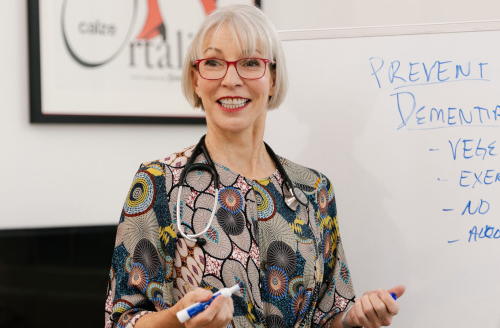Even if you walk slowly, even if you walk uncertainly, even if your joints are a little sore, even if you’re a little afraid of falling, even if walking makes you tired, just walk!
As I do geriatric house calls around the San Francisco Bay Area, I find myself harping on this basic message again and again: Keep moving; as much as you can; as long as you can.
Why?
Because our bodies are meant to work and move, and when they don’t work or move, our physical systems start to go ker-fluey. My favorite statistic: For every day a patient spends in bed not moving, that elder patient loses 5 percent of their muscle mass, non-elderly adults lose 1%. Patients who don’t move just get inexorably weaker. And with elderly patients lost strength can be regained, but it’s not clear how much comes back.
I now have a patient who is just recovering from a hospitalization. He was walking pretty well before the hospital, but now he needs help and encouragement to walk. I met with the physical therapist (PT) at his residence, and the PT told me that he was having my patient walk once a day for 10 minutes.
I had to struggle to keep my temper as I heard this. I asked the PT, “Do you really think that 10 minutes a day is enough for this patient to regain his strength and to get back to walking regularly again?”
“Yes, I do,” the PT said.
Well, I’m sorry, but that’s just wrong. We shouldn’t give up on our elders this so quickly.
Just a few weeks previously, as I’ve said, this man was walking pretty well. He could get back to walking pretty well, but it will take work. That means way more walking than 10 minutes a day. With that little exercise, this man has no hope of regaining his former strength. Now, if this man walks 10 minutes, four or five or six times a day, then maybe that will be enough. Maybe he will regain most of his strength.
But if he doesn’t walk a lot, then he will just get weaker. This is not “normal aging.” This is not “expected decline.” This is preventable decline.
So if you have an elder who’s just back from a hospital stay, and less steady and strong, don’t assume that your elder will just have to settle for this lower level of physical strength. Push PTs and caregivers to make sure he walks, every day, several times a day, as many times as the patient will tolerate.
Just walk! It’s important.
Elizabeth Landsverk, MD

Elizabeth (Dr Liz) has over twenty years of experience in providing medical care to the elders. She is board-certified in Internal Medicine, Geriatric Medicine and Palliative Care Medicine. Dr Landsverk founded ElderConsult Geriatric Medicine, a house calls practice, to address the challenging medical and behavioral issues often facing older patients and their families.

